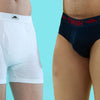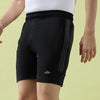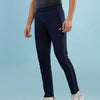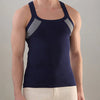Difference Between Brief And Trunk Underwear What's The Best Fit For You.

Why Understanding Underwear Fit Matters
Let’s face it—underwear is the foundation of your everyday comfort. Yet, most men overlook the importance of choosing the right style. From support and style to fit and function, the difference between briefs and trunks can have a big impact on your daily comfort and confidence.
In this guide, we'll break down the fit differences between men's trunks and briefs, explore how hipsters compare to trunks, and help you decide which style suits your body and lifestyle best.
Difference Between Brief and Trunk
- Fit and Support
- Briefs: Designed for maximum support, especially in the pouch and seat areas. Ideal for high-intensity activities, they prevent movement and provide a snug, secure feel.
- Trunks: Offer moderate support with a shorter leg cut. They balance comfort and control, making them ideal for casual or everyday wear.
- Leg Length and Cut
- Briefs: Feature high-cut leg openings that expose more thigh and prevent bunching—great for mobility.
- Trunks: Have a square-cut design that extends slightly down the thighs, offering more leg coverage.
- Waistband and Rise
- Briefs: Sit at or just below the natural waistline, offering a traditional, higher rise.
- Trunks: Sit lower on the hips, appealing to those who prefer a more modern, low-rise silhouette.
How Does the Fit of Men's Trunks Compare to Briefs?
In short:
- Briefs = snugger fit, higher waistband, and more support.
- Trunks = roomier leg area, modern cut, and balanced support.
Briefs are great for:
- Men with active lifestyles
- Those who prefer firm support
- Wearing under tighter pants
Trunks are ideal for:
- Men who want more thigh coverage
- Slim or athletic builds
- Daily casual wear
Difference Between Hipsters and Trunks
While both offer a lower rise, hipsters and trunks differ slightly:
- Hipsters: Typically sit even lower on the hips and offer less leg coverage. They’re a blend between trunks and bikini-style underwear.
- Trunks: Offer a square shape with short leg length and slightly more coverage, making them more versatile for various body types.
Trunks vs Briefs: Key Comparison Table
|
Feature |
Briefs |
Trunks |
|
Fit |
Snug and supportive |
Snug to semi-snug |
|
Rise |
High rise |
Low rise |
|
Leg Coverage |
Minimal (high-cut) |
Short (mid-thigh) |
|
Best For |
Active wear, tight pants |
Everyday wear, modern aesthetic |
|
Body Type |
All types |
Slim/Athletic |
|
Support Level |
Maximum |
Moderate |
FAQs: Briefs vs Trunks and More
- What’s better: briefs or trunks?
It depends on your needs. If you want maximum support and a traditional style, go for briefs. If you prefer a modern look with more thigh coverage, trunks are better.
- Do trunks provide enough support for workouts?
Trunks offer decent support, but briefs are better for high-impact activities due to their firm hold and reduced movement.
- Are hipsters the same as trunks?
No. Hipsters sit lower and have less leg coverage, making them slightly more revealing than trunks.
- Which is more comfortable for daily wear?
Trunks tend to be more comfortable for everyday use, while briefs are ideal when you need strong support and minimal movement.
- What type of underwear is best for tight jeans or pants?
Briefs are best under fitted clothing because they reduce bunching and eliminate visible lines due to their high-cut design.
Conclusion: Which Should You Choose?
Whether you’re trying to understand the difference between brief and trunk, or deciding between hipsters and trunks, it all boils down to comfort, activity level, and personal preference.
- Choose Briefs if:
✅ You need strong support
✅ You’re active or athletic
✅ You prefer a classic look - Choose Trunks if:
✅ You want modern style and moderate coverage
✅ You prefer comfort for everyday wear
✅ You have a slim or athletic build
Final Tip: Don’t Forget Fabric and Fit
Regardless of the style, always check:
- Fabric: Cotton for breathability, Modal for softness, Microfiber for performance
- Fit: Use size charts, avoid too tight or loose bands
- Pouch design: Contoured pouches provide added comfort and support
Explore your fit. Elevate your comfort. Choose wisely.


 Contact Us
Contact Us



